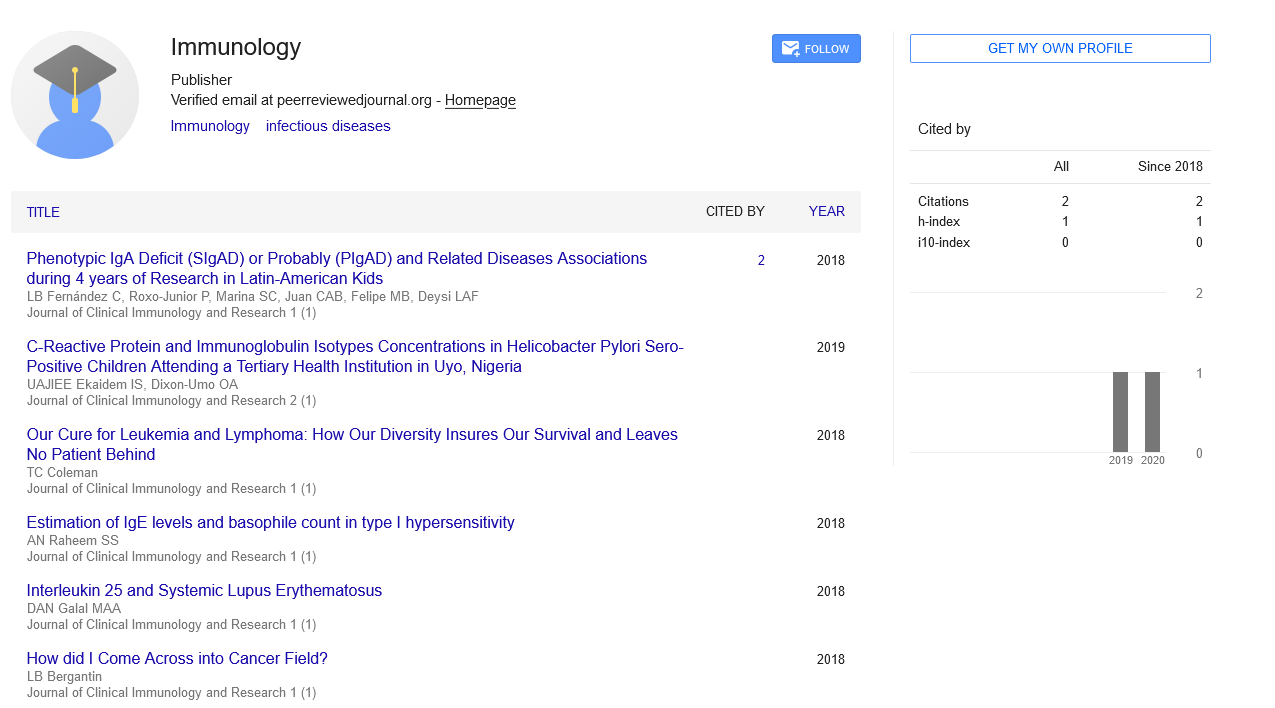Perspective, J Clin Immunol Res Vol: 6 Issue: 1
Membrane and Mucosal Immunomodulatory Mechanisms
Ting Cheg*
1Department of Pharmacology, Shenyang Pharmaceutical University, Shenyang, Liaoning, China
*Corresponding Author: Ting Cheg
Department of Pharmacology, Shenyang
Pharmaceutical University, Shenyang, Liaoning, China
E-mail: tinch@syphu.edu.cn
Received date: 19 March, 2023, Manuscript No. JCIR-23-99625;
Editor assigned date: 22 March, 2023, PreQC No. JCIR-23-99625 (PQ);
Reviewed date: 05 April, 2023, QC No. JCIR-23-99625;
Revised date: 12 April, 2023, Manuscript No. JCIR-23-99625 (R);
Published date: 19 April, 2023, DOI: 10.4172/JCIR.100072
Citation: Cheg T (2023) Membrane and Mucosal Immunomodulatory Mechanisms. J Clin Immunol Res 6:1.
Description
Immunomodulatory mechanisms play an important role in maintaining immune homeostasis and regulating immune responses at membrane and mucosal surfaces. These surfaces act as the first line of defense against pathogens and environmental challenges. The immune system at membrane and mucosal sites exhibits unique characteristics and employs specialized mechanisms to promote protective immunity while preventing excessive inflammation and tissue damage. Understanding the immunomodulatory mechanisms operating at these sites is essential for developing targeted interventions to regulate immune responses and prevent immune-related diseases.
The epithelial barrier is a physical barrier that separates the external environment from the internal tissues. It plays a vital role in preventing the entry of pathogens and harmful substances. The epithelial cells lining the membrane and mucosal surfaces are equipped with various immunomodulatory mechanisms, including tight junctions, mucus production, and antimicrobial peptides. These mechanisms help maintain barrier integrity, regulate the selective transport of molecules, and modulate immune cell interactions.
Toll-Like Receptors (TLRs) and other Pattern Recognition Receptors (PRRs) recognize Pathogen-Associated Molecular Patterns (PAMPs) and Danger-Associated Molecular Patterns (DAMPs) present on pathogens or damaged cells. They are expressed on epithelial cells, immune cells, and other resident cells at membrane and mucosal sites. Activation of TLRs and PRRs triggers innate immune responses, leading to the production of pro-inflammatory cytokines, chemokines, and antimicrobial factors. These receptors also play a role in shaping adaptive immune responses by influencing antigen presentation and T cell activation.
Regulatory T cells (Tregs) are a subset of CD4+ T cells with immunosuppressive properties. They play a vital role in maintaining immune tolerance and preventing excessive immune responses at membrane and mucosal sites. Tregs suppress effector T cell functions and modulate the activity of other immune cells through various mechanisms, including the secretion of immunosuppressive cytokines like Interleukin-10 (IL-10) and Transforming Growth Factor-beta (TGF-β). Tregs help prevent immune-mediated tissue damage and promote immune homeostasis.
Secretory Immunoglobulin A (sIgA) is the predominant immunoglobulin isotype found at mucosal surfaces. It plays a vital role in immune defense by binding to pathogens and preventing their attachment to epithelial cells. sIgA also promotes the clearance of pathogens through mechanisms such as immune exclusion, immune aggregation, and neutralization. Moreover, sIgA acts as an immunomodulator by interacting with immune cells and modulating their functions, thereby influencing the overall immune response at mucosal sites.
Cytokines are key signaling molecules involved in immune cell communication and regulation. They orchestrate immune responses at membrane and mucosal sites by influencing immune cell recruitment, activation, differentiation, and effector functions. Various cytokines, such as Interleukin-17 (IL-17), Interleukin-22 (IL-22), and interferons, play important roles in maintaining barrier integrity, promoting tissue repair, and modulating immune cell activity. Crosstalk between immune cells, epithelial cells, and resident cells is important for effective immune responses and immunomodulation at these sites.
Conclusion
Membrane and mucosal immunomodulatory mechanisms are essential for maintaining immune balance, preventing excessive inflammation, and protecting against pathogens. The epithelial barrier, toll-like receptors, regulatory T cells, secretory immunoglobulin A, cytokines, and immune cell crosstalk collectively contribute to immunoregulation and immune homeostasis at these surfaces. Understanding these mechanisms is important for developing targeted therapeutic interventions to modulate immune responses and prevent or treat immune-related diseases at membrane and mucosal sites.
 Spanish
Spanish  Chinese
Chinese  Russian
Russian  German
German  French
French  Japanese
Japanese  Portuguese
Portuguese  Hindi
Hindi 